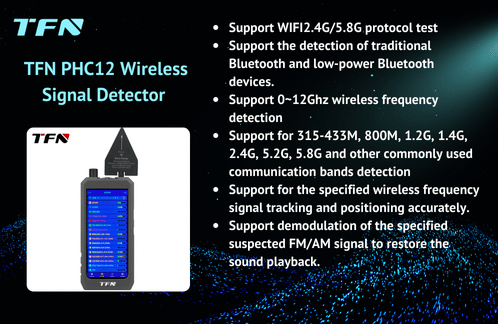How can I use a wireless signal detector to detect GPS trackers in express packages?
With package security a growing concern, hidden GPS trackers can be used to illegally track items or personal information. TFN recently received a request from a client in a European country. Following a theft involving GPS tracking and recording devices hidden inside packages, they needed a signal detection device to detect illegal GPS trackers. The TFN PHC12 handheld wireless signal detector, with its powerful 1MHz-12GHz full-band scanning capability, is a powerful tool for accurately locating such devices, meeting this client's needs. Below, we'll explain how to use a wireless signal detector to detect GPS trackers in express packages (using the TFN PHC12 as an example).
1. Device Preparation and Environment Setup
1.1. Turn on the PHC12 and select a mode.
Upon powering on, the device defaults to "Signal Check Mode." Click the "Start" button at the top of the screen to automatically scan for RF signals, including mobile, WiFi, Bluetooth, and GPS trackers.
1.2. Isolate the Package to Reduce Interference
Place the package to be inspected on an open surface (away from electronic devices such as mobile phones and routers). The PHC12's "Real-Time Spectrum Mode" displays the current ambient signal baseline, making it easier to compare anomalies later.
2. Accurate Scanning and Signal Identification
2.1. Preliminary Screening of Suspicious Signals
In "Signal List Mode," check the "Common Wireless Communication Bands" or "Other Abnormal Signals" columns.
GPS trackers typically operate in 1.2GHz, 1.5GHz (L1/L2 bands), or 2.4GHz (some low-power models). The PHC12 displays the signal's peak frequency and field strength (in dBm) in real time.
2.2. Comparison with the Signal Signature Library
The device has a built-in library of signatures for stealth devices. If an unknown RF source matching the GPS signal signature is detected, the system will trigger an alert (yellow or red indicator) and display the frequency, strength, and estimated device type in a list.
3. Locating and Confirming the Target
3.1. Enable Spectrum Flowchart Analysis
Enter "Real-Time Spectrum Mode" and click "Spectrum Recording" to record the package signal. Use the waterfall chart to observe changes in signal strength over time—a continuously transmitted, stable signal is likely a GPS tracker (as opposed to a mobile phone that operates intermittently).
3.2. Use the Signal Locating Function to Pinpoint the Target
Select the suspected GPS signal in the signal list to enter the "Target Locating Interface."
Slowly move the PHC12 around the package and observe the signal strength indicator (green → red for weak → strong). As the device approaches the tracker, the alarm will gradually increase in intensity, and the peak value of the on-screen bar graph will increase significantly.
Use this combination of directional positioning to locate the strongest signal point (usually the GPS antenna location).
4. Advanced Verification and Processing
1. Demodulated Signal Verification (Optional)
For some GPS devices that support voice transmission, use the "Signal Demodulation" function to attempt to demodulate the AM/FM signal. If you hear a data stream or voice, you can further confirm the risk.
2. Shielding Test
Cover the suspected area of the package with metal foil. If the signal strength drops sharply, you can determine the location of the GPS tracker. The "Background Comparison" function of PHC12 can quantify the difference in signal before and after masking.
Key Operating Tips
Sensitivity Adjustment: Narrow the monitoring frequency band (e.g., 1.5-1.6GHz) in "Software Settings" to improve the signal-to-noise ratio.
Long-lasting Battery Life: The PHC12's 4820mAh battery provides 4-5 hours of continuous scanning, enabling high-volume detection.
Data Logging: Detection results automatically generate a log (including time, signal type, MAC address, etc.), which can be exported as an .xls file via the history list for easy forensic analysis.

Why Choose the TFN PHC12?
Its 6.67-inch HD screen displays a real-time spectrum waterfall and signal strength curve. Its octa-core processor ensures millisecond-level response for 23 signal types, including GSM/CDMA/5G NR/GPS/Bluetooth, within the 1MHz-12GHz frequency band. Its "one-button detection" logic, designed specifically for security, makes covert trackers invisible.
Conclusion: The key to using a wireless signal detector to combat package tracking lies in "isolation environment → full-frequency scanning → signature comparison → precise positioning." TFN PHC12 uses military-grade RF analysis capabilities to transform professional anti-theft technology into a simple three-step operation, building a dynamic shield for personal privacy and logistics security.
